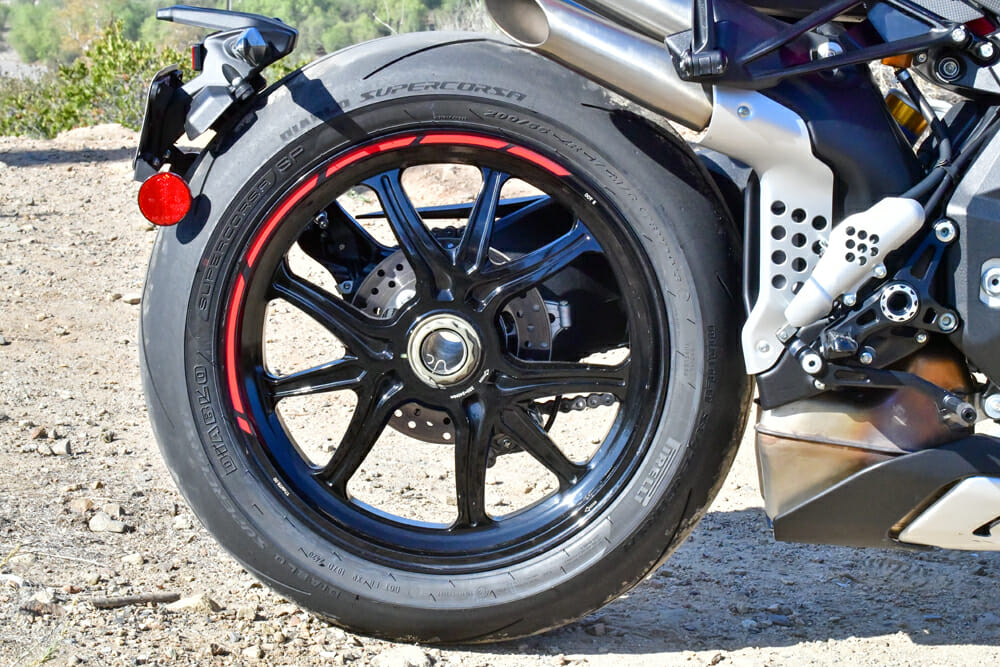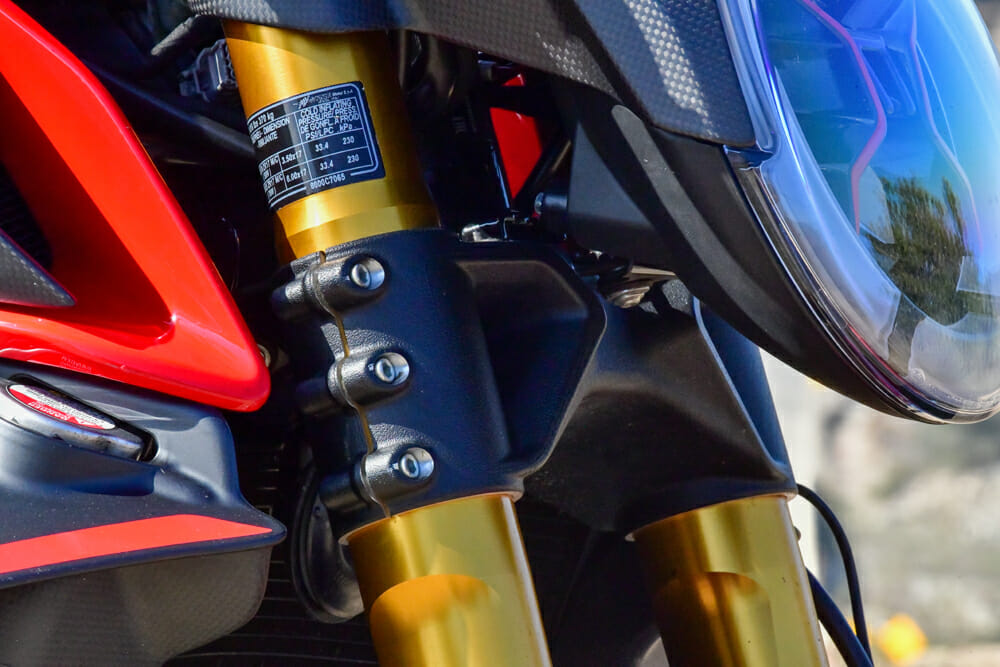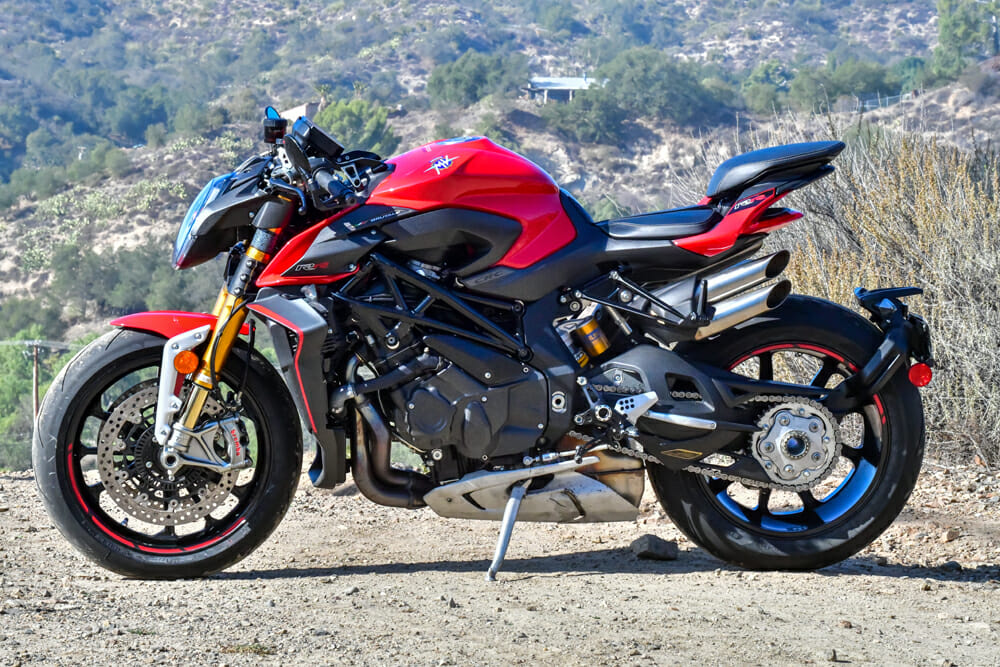2022 MV Agusta Brutale 1000 RR Review
Rennie Scaysbrook | January 28, 2022
MV Agusta make stunning motorcycles. Indeed, their company slogan is “We craft emotions.” But is the Brutale 1000 RR a stretch too far?

By Rennie Scaysbrook | Photography by Kit Palmer
Okay. Full disclosure here. I’m a fan of MV Agusta. Have been for many, many years. I think my fandom emits from a love of the brand’s history, when Giacomo, Mike and Phil, glorified the 1960s with their dashing displays of motorcycle daring on the world’s most lethal circuits.
Or perhaps it was solidified when “the most beautiful superbike ever created” (my opinion, not universal), the original 750 F4, was released in the 1990s. Or when MV created a mobility scooter that looks like something a New York artist would roll into his studio on. Who knows?
MV Agusta pushes the boundaries of artistic mechanical flair harder and further than any other. Art and motorcycling is, for some, inexorably linked, and it’s easy to see our test bike, the Brutale 1000 RR, has been whacked pretty heavily with the artist’s brush.

“Man, that is an ugly motorcycle,” says Kit Palmer as we shoot it for this article. “There’s nothing on it I find even remotely attractive. The headlight, the seat, even the exhaust, just… no.”
For me, I quite like the Brutale’s aesthetic. It’s a muscly, angry looking motorcycle, like a gym junkie in a dinner suit. That bulging 1000cc inline four-cylinder, holding titanium valves and conrods and boasting a claimed 208 horsepower between the cylinder walls, draws the eye in, leading to a pair of divinely sharp exhaust mufflers that exit either side of the tiny passenger seat.
The overly manufactured middle triple-clamp, the liberal lashings of carbon-fiber, the nine-spoke forged aluminum rear wheel mated to a trademark MV single-sided swingarm, and the clip-on handlebars that belong on a superbike, not a naked bike. For me, it’s a hard yes in the looks department.
Regardless of mine or Kit’s feelings, this MV Agusta is about as far removed from the gloriously flowing lines of the darling of 1960s grand prix racing, the 500cc three-cylinder, used by Ago et al, as could possibly be.
As the old saying goes, beauty really is in the eyes of the beholder.

At $33,800, the MV Agusta Brutale 1000 RR is right up there with the most expensive mass-produced naked bikes on the planet. In fact, it very nearly tops them. Only the Ducati Streetfighter V4 SP comes in higher, and that machine includes more cubes (although the same claimed power of 208 horsepower), an STM dry slipper clutch, carbon-fiber wheels, and more. But if you’re talking limited editions, their own Brutale 1000 Nürburgring comes in a great deal more at $44,160.
So, you’re dealing with a bespoke package for a discerning buyer that’s got cash to burn and a license to shred. It’s already quite a hard sell for MV, especially when you consider their smaller 800cc Brutale range is quite underrated. Does the ride live up to the admittedly very high expectations? Again, it depends on who you are.
Let’s get the obvious stuff out of the way first. Yes, it’s fast as hell. The motor has a ferocity that leaves you in no doubt of its intentions, as it doesn’t do low-speed city sweeping well, the slightly erratic fueling only sorting itself out when the twist grip is wound right back, air is flowing, and gas it sent to the combustion chamber with high force.

There’s a dastardly flat spot below 4000 rpm, which is right where the clutch will drop you if you’re doing casual traffic light starts. It therefore pays to keep the revs north of 5000 rpm everywhere, lest the old lady in the Camry behind you rams you from behind for not taking off faster at the lights. On a Brutale. With 208 horsepower. Hmm.
Ride the Brutale like you stole it and it makes sense—tucked down, throttle pinned with the revs held high. Hold the motor above 8000 rpm and the atmosphere is hurtled towards to at an alarming rate, and you’re very thankful for the Brembo Stylema monobloc calipers and the electronic Öhlins NIX30 fork/TTX shock to keep everything on the straight and narrow.
Brutally quick, accompanied by a cacophony of noise that is wholly unattractive on cold starts, the Brutale will turn every head it rides past. You can’t not look, especially as the lack of fairing mated to clip-on handlebars is at odds with the traditional naked bike demeanor.

Those handlebars help the Brutale rider load the front tire up in a far superior manner than on something like a KTM 1290 Super Duke R. Your body is lower to the front axle and you can properly bury the front under braking, pushing the Pirelli into the tarmac as you sail around long, sweeping bends.
In tight city streets, however, the ride position is, shall I say, a case of form over function. Unless you’re pushing hard, and measure less than 5’9” in height, the Brutale is about as comfortable as a trip to the chiropractor, which you’ll need after a few rides, anyway.
It’s here the exhausts play a bigger role than they should in the ride position. Wait. Exhausts? What the hell have they got to do with the ride position? Put simply, when you get in the attack riding position, your feet will clatter against the backs of the mufflers on the black heel guards and passenger pegs, making it near impossible to find a comfy place to rest your feet. Combine this with the plank-hard seat and the extra weight on your wrists with the aforementioned handlebar position, and I can only conclude this is a naked bike that is far more uncomfortable than even MV Agusta’s own F3 supersport bike, thus negating the benefits of like, you know, naked bike riding. There’s a first time for everything.
Anyway, moving on.

It should be of no surprise to know the Brutale comes with all the electronics you’d expect for a $35K-plus naked sport bike, but in typical MV fashion they are bloody irritating to use. The radially mounted 5.5-inch dash is a jewel of industrial design, the unit looking like it’s floating above the tank, but accessing the various modes and settings like TC and wheelie quickly is not high on the Brutale’s “to-do” list.
An area of continual frustration for modern MV’s (as I experienced on the Super Veloce) is the fact that the right-side cruise control does not disengage when you roll the throttle back against the stop. This seemingly innocuous trait is in fact quite dangerous, and the system requires a hefty stab at the brakes to let go of the throttle bodies and for you to start slowing down. This is something that needs to be remedied and quick.

The IMU is supplied by Continental, and I’ll straight up admit on the street I did not get the MV working fast enough to need it and thus could tell you if it’s better than a Bosch unit or not. I don’t think anyone could. But it’s nice to know it’s there.
I must be honest and say I expected more from the Brutale 1000 RR, especially for the price. The combination of a poorly thought-out riding position, that flat spot, a pretty notchy quickshifter, a seat that feels like concrete and difficult electronics make this a bike for a very, very certain type of customer.

These issues are not difficult to fix, and I certainly hope MV takes a look at how it can make a bike like this, that has such aurora, such charisma, a little more applicable to the real world.
To that end, I am waiting with bated breath for my turn on the Brutale 1000 RS, which takes the naked part of naked biking a little more seriously. The 1000 RS comes with a proper single-piece handlebar, plusher seat and I’m told the flat spot is cured, so hopefully I come away with higher praises than I did on the RR.
I’m still that MV Agusta fan I was at the beginning of this article, and I still love the look, but after riding the Brutale 1000 RR for a while, I like it just a little less now. CN

2022 MV Agusta Brutale 1000 RR Specifications
| MSRP: | $33,800 |
| Engine: | 4-stroke, inline-4 |
| Valvetrain: | 16 valves, DOHC |
| Displacement: | 998cc |
| Bore x stroke: | 79 x 59mm |
| Compression ratio: | 13.4:1 |
| Power (claimed): | 208 hp @ 13,000 rpm |
| Torque (claimed): | 85 lb-ft @ 11,000 rpm |
| Exhaust: | 4/1/2004 |
| Transmission: | 6-speed with quickshift |
| Clutch: | Multi-plate wet clutch with mechanical slip system |
| Electronics: | Eight level traction control, ABS with race mode, Cornering lights, cruise control, four engine maps, (Rain, Road, Sport, Race), Continental IMU |
| Chassis: | Tubular steel trellis |
| Front suspension: | Öhlins NIX30 43mm inverted fork, fully adjustable, Öhlins Smart EC suspension |
| Rear suspension: | Öhlins TTX36 monoshock, fully adjustable, Öhlins Smart EC suspension |
| Front wheel travel: | 4.72 in. |
| Rear wheel travel: | 4.72 in. |
| Front brake: | Brembo radial 4-piston calipers, dual 320mm discs, Continental MK100 with RLM (Rear Wheel Lift-up Mitigation) and with cornering function |
| Rear brake: | 2-piston Brembo caliper, single 220mm, Continental MK100 with RLM (Rear Wheel Lift-up Mitigation) and with cornering function |
| Front tire: | 120/70 – ZR 17 M/C (58 W) Pirelli Diablo Rosso Corsa II |
| Rear tire: | 200/55 – ZR 17 M/C (78 W) Pirelli Diablo Rosso Corsa II |
| Wheelbase: | 55.71 in. |
| Seat height: | 33.2 in. |
| Fuel capacity: | 4.23 gal. |
| Weight (dry, claimed): | 410 lbs. |

Click here to read the 2022 MV Agusta Brutale 1000 RR Review in the Cycle News Digital Edition Magazine.
Click here for the latest Cycle News Sportbike motorcycle reviews and news.
Click here for more MV Agusta motorcycle reviews and news.
